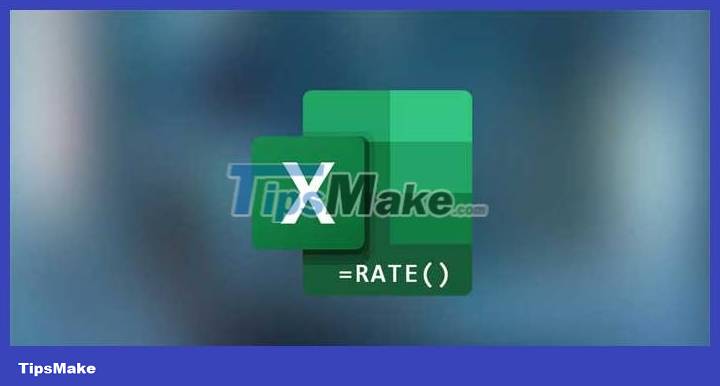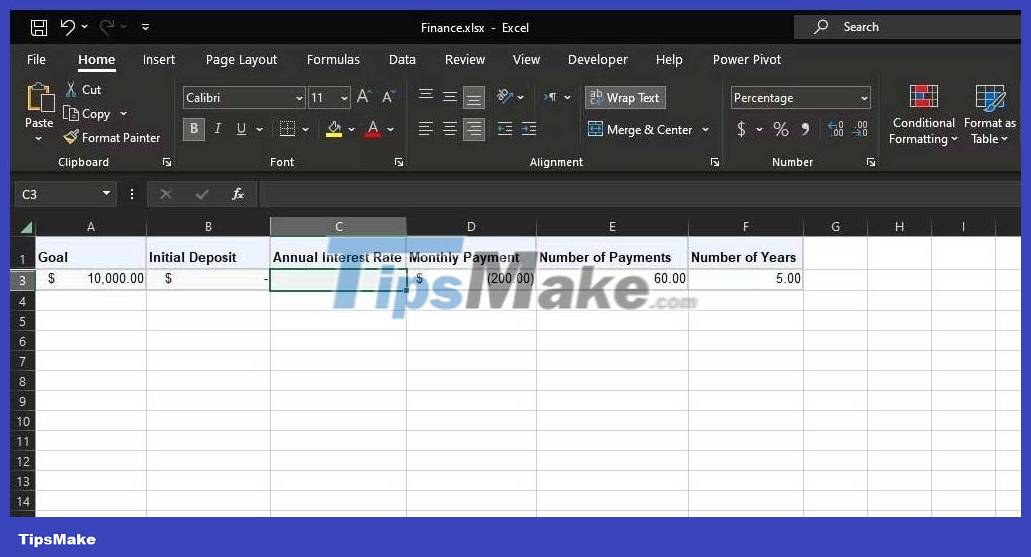How to calculate interest rate using the RATE function in Excel
You can absolutely calculate interest rates right in Excel . The following are detailed instructions on how to calculate interest rates using the RATE function in Microsoft Excel .

Interest rates are an important component of financial management, for both loans and savings. This interest rate determines how much you will pay on a loan or earn from savings over time.
The RATE function is a tool that can help you accurately calculate interest rates, plan your finances, and make more manageable decisions. The loan and savings interest calculations are the same, just tweaked a bit for owners and debtors.
What are loan and savings interest rates?
Lending interest rate : When borrowing money, the interest rate represents the cost of borrowing. When borrowing money, the interest rate represents the cost of borrowing. It is calculated as a percentage of the principal amount borrowed and added to the original amount you owe. A higher loan interest rate means you will pay more over the life of the loan.
Savings interest rates : On the other hand, when you deposit money in a savings account, the interest rate determines how much your money will grow over time. This rate is expressed as a percentage, and the interest earned is usually added to your savings periodically.
A savings account is essentially a loan account, except that you are lending money to the bank and the bank now owes you money. So the longer your savings stay in the bank, the more the bank will owe you.
RATE function in Microsoft Excel
RATE is a financial function available in Excel, designed to calculate interest rates based on other financial factors. The syntax here is:
=RATE(nper, pmt, pv, [fv], [type], [guess])- NPER: Total number of payment periods, can be months, years, etc
- PMT: A periodic payment made or received each period, which can be negative for loans (payments) or positive for savings (deposits).
- PV: Principal amount, total initial amount involved.
In addition, the RATE function also has 3 optional arguments:
- FV: Desired future investment or loan value. If left blank, RATE will calculate the loan interest rate and set the FV to 0.
- Type: Indicates when payment is due. The default value is 0, meaning payment is made at the end of the cycle. 1 means payment is paid at the start of each cycle.
- Guess: Predict interest rates. It provides a starting point for the RATE function. By default, this function gives the value 10.
The RATE function calculates the interest rate required to achieve a specific future value using these parameters. The RATE function returns a fixed interest rate and cannot calculate compound interest.
If you're new to finance in Excel, it's best to start with the NPER function to understand the payment stages in loans and savings.
Example 1: Calculate loan interest rate
Let's say you're considering a $10,000 loan with monthly payments of $200 for 5 years and you want to calculate the interest rate. For loans, PMT, NPER, and PV will be the negative monthly payment amount, number of monthly payments, and loan amount, respectively.

You can use the RATE function as follows to quickly calculate the interest rate for a loan:
=RATE(E3, D3, A3)The result will be the monthly interest rate. To calculate the annual interest rate, you can multiply it by 12:
=RATE(E3, D3, A3)*12 
Example 2: Calculate savings interest rate
Imagine you are planning to save $5,000 monthly by depositing $100/month for 3 years after making an initial deposit of $200. In this case, you have four arguments: PMT, NPER, PV, and FV. These would be the negative monthly payment amount, the number of monthly payments, the negative initial deposit amount, and the corresponding savings goal.

You can use the RATE function in Excel to calculate the interest rate needed to reach your loan goal as follows:
=RATE(E3, D3, B3, A3)The above function will calculate the monthly interest rate for you. Multiply it by 12 to calculate the annual interest:
=RATE(E3, D3, B3, A3)*12 
The RATE function in Microsoft Excel is a valuable tool for those who have loans or savings. It simplifies complex interest rate calculations, allowing you to make informed financial decisions.
Understanding how to use this function can help you control your finances well in the future.
You should read it
- PMT function in Excel - Usage and examples
- The easiest way to calculate the percentage (%)
- How to calculate the interest rate for bank deposits
- CUMIPMT function - The function of calculating accrued interest in Excel
- MIRR function - The function returns the adjusted internal rate of return in Excel
- How to Calculate Average Growth Rate in Excel
- How to Calculate Data Transfer Speed
- Use the cumulative interest calculation function in Excel
May be interested
- How to calculate the interest rate for bank deposits
 bank deposits are now one of the safest and most secure ways to invest. currently, in addition to direct transactions at the bank, some banks also have a service of saving money directly through the electronic banking application.
bank deposits are now one of the safest and most secure ways to invest. currently, in addition to direct transactions at the bank, some banks also have a service of saving money directly through the electronic banking application. - How to use the kernel function (PRODUCT function) in Excel
 in excel, product helps users to calculate product values, multiply arguments together, and return their results correctly.
in excel, product helps users to calculate product values, multiply arguments together, and return their results correctly. - SUM function in Excel: How to use SUM to calculate totals in Excel - SUM function in Excel
 the sum function in excel is quite commonly used. below are details on how to calculate the sum function and related issues in microsoft excel.
the sum function in excel is quite commonly used. below are details on how to calculate the sum function and related issues in microsoft excel. - How to use DSUM function in Excel
 the dsum function on excel is used to calculate the conditional sum in a field, or column in the data list.
the dsum function on excel is used to calculate the conditional sum in a field, or column in the data list. - MIRR function - The function returns the adjusted internal rate of return in Excel
 sometimes in the process of investing in securities you wonder and do not know when you can payback or how to calculate whether the next investment is profitable or not. the following article shows how to use the mirr function to help you answer the above question.
sometimes in the process of investing in securities you wonder and do not know when you can payback or how to calculate whether the next investment is profitable or not. the following article shows how to use the mirr function to help you answer the above question. - 3 ways to calculate totals in Excel
 to calculate totals on excel, users can use them in three different ways, based on spreadsheets, autosum functions or sum functions with large data areas.
to calculate totals on excel, users can use them in three different ways, based on spreadsheets, autosum functions or sum functions with large data areas. - SUMPRODUCT function in Excel: Calculates the sum of corresponding values
 the sumproduct function is an extremely useful function when you have to deal with a lot of data numbers in microsoft excel. here are the things you need to know about the sumproduct function in excel.
the sumproduct function is an extremely useful function when you have to deal with a lot of data numbers in microsoft excel. here are the things you need to know about the sumproduct function in excel. - DAYS function, how to use the function to calculate the number of days between two time points in Excel
 the days function in excel returns the results between two different timelines.
the days function in excel returns the results between two different timelines. - Basic Excel functions that anyone must know
 the basic functions in excel such as the excel function, the excel statistics function we summarized below will be very helpful for you who often have to work on excel spreadsheets, especially in the field of accounting. let's refer to offline.
the basic functions in excel such as the excel function, the excel statistics function we summarized below will be very helpful for you who often have to work on excel spreadsheets, especially in the field of accounting. let's refer to offline. - FVSCHEDULE function - Returns the future value of an investment that has variable or adjustable interest in period in Excel
 the following article details the meaning and usage of the fvschedule function - returns the future value of an investment that has an interest rate that changes or can be adjusted periodically in excel.
the following article details the meaning and usage of the fvschedule function - returns the future value of an investment that has an interest rate that changes or can be adjusted periodically in excel.










 How to use the MROUND function in Excel
How to use the MROUND function in Excel How to create image borders in PowerPoint
How to create image borders in PowerPoint How to create borders in PowerPoint
How to create borders in PowerPoint How to display secondary time zones in Google Calendar
How to display secondary time zones in Google Calendar How to Make a Copy of a Page in a PDF Document
How to Make a Copy of a Page in a PDF Document